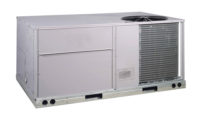Contractors know that improving energy efficiency is an effective way to cut expenses for facility managers and homeowners. Properly sealing and maintaining heating and cooling ducts is a low-cost measure that can improve energy efficiency in both residential and commercial applications. Learn how the selection and correct application of film tapes to properly seal reflective insulation and achieve high R-value will lower energy consumption and costs in clients’ homes and businesses. Plus, find out how to avoid the costly repercussions of using the wrong tape.
Properly Sealed Insulation is Key

(Courtesy of Shurtape)
Achieving full system closure—meaning that the entire HVAC system is free of leaks—is essential for running at peak efficiency. In order to meet code, ductwork that runs through unconditioned spaces (attics, crawlspaces, basements, garages, etc.) must be properly insulated and sealed with the correct HVAC tape.
There are several different options when insulating an HVAC system, including reflective insulation. Wrapping ductwork in the insulation protects the conditioned air inside the duct from the cold air surrounding the ductwork. This keeps the mechanically warmed air inside the duct as close to the desired, constant temperature as possible and helps to reduce energy consumption, increasing system efficiency.
Film Tape, Foil Tape and R-Value
Reflective insulation uses an R-value to measure the insulation’s ability to reduce radiant heat loss. This is a key measurement because a higher R-value represents greater insulating power. The amount of air space between the reflective insulation and the surface it is insulating, such as a metal duct, affects the R-value greatly. Having an air gap is necessary for reflective insulation to be effective. The amount of empty space in that gap impacts the insulation’s ability to reduce radiant heat loss, therefore determining the R-value.
“Some systems can be insulated with one layer of reflective insulation, and for other projects, two layers of reflective insulation may be installed,” said Lisa Zierfuss, product manager at Shurtape Technologies, LLC. “However, there must also be a proper air gap between the layers of insulation, in addition to the air gap between the first layer and the duct work. To ensure the insulation retains its R-value, an airtight seal with a quality film tape is essential.”
To achieve full system closure, film tapes is an option for reflective insulation.
Film tape is pliable and conforms easily to the inconsistent surface of reflective insulation. When technicians squeegee the tape into place during installation, film tape works its way into all the tiny crevices. This higher conformability ensures 100% surface contact for a complete seal when joining or patching the insulation.
Working with film tape also tends to be less frustrating and reduces product waste because it can be easily pulled apart when a strip folds over and sticks to itself, then applied to the HVAC surface.
And because film tape rolls are a light weight, they’re easy to work with and maneuver, particularly when technicians are working in the typically tight, awkward spaces where HVAC ductwork resides in a building.
Application Best Practices
To achieve a high R-value on HVAC ductwork, installers should apply 2-3 inch wide strips of reflective insulation around the circumference of the air duct, along the full length of the duct at certain intervals.
In addition, it is crucial to ensure there is the right amount of air gap in between the insulation and the duct. Film HVAC tape is used to secure these insulation strips, as well as seal an outer layer of reflective insulation that will cover the surface of the duct. Selecting the proper tape is imperative because it is the primary barrier against leaks that could compromise the insulation’s performance.
Choosing the Wrong Tape Leads to Failure
As noted above, ductwork that requires insulation is usually located in unconditioned areas of the building, which means it is subject to extreme temperature fluctuations. When the wrong tape is exposed to cold (or hot) temperatures it becomes brittle or shrinks up, leading to tape failure. When tape adhesion fails, the seal is broken and full system closure is compromised—resulting in inefficiency and higher HVAC costs. It is important to select a tape that is engineered to produce a permanent seal on reflective insulation and withstand multiple thermal cycles.
Efficient HVAC Systems Save Clients Energy and Money
Homes and commercial buildings consume 40% of the energy used in the United States. And of that 40%, 54% is used for heating and cooling. By including simple steps to improve HVAC systems, buildings can become more energy efficient and lower costs. Making sure ductwork and other HVAC components are properly insulated and secured with the correct HVAC film tape will result in more energy efficient buildings and satisfied clients.
Content provided by Shurtape






